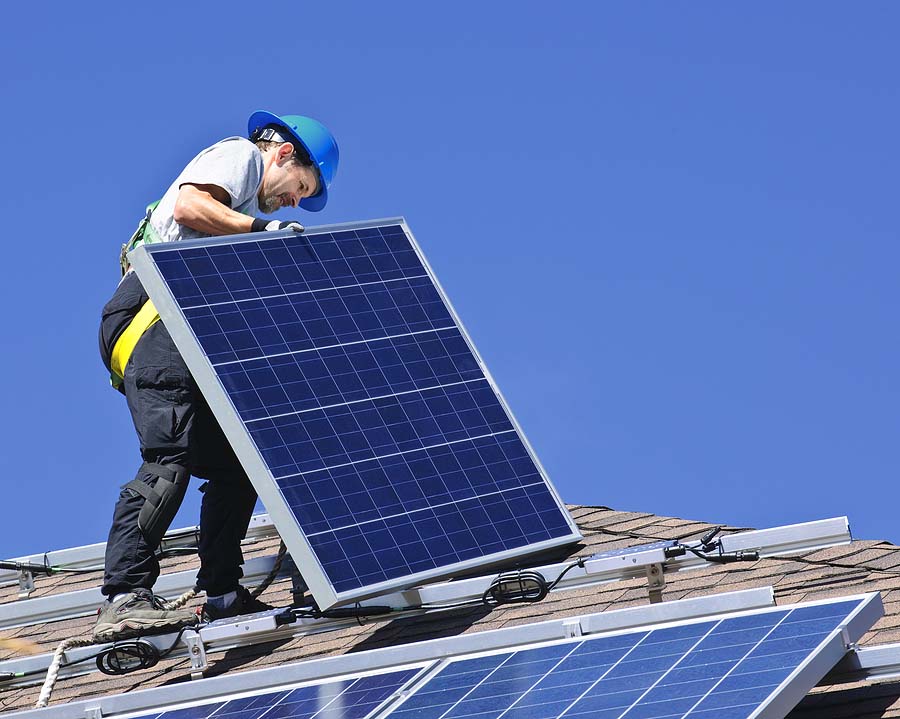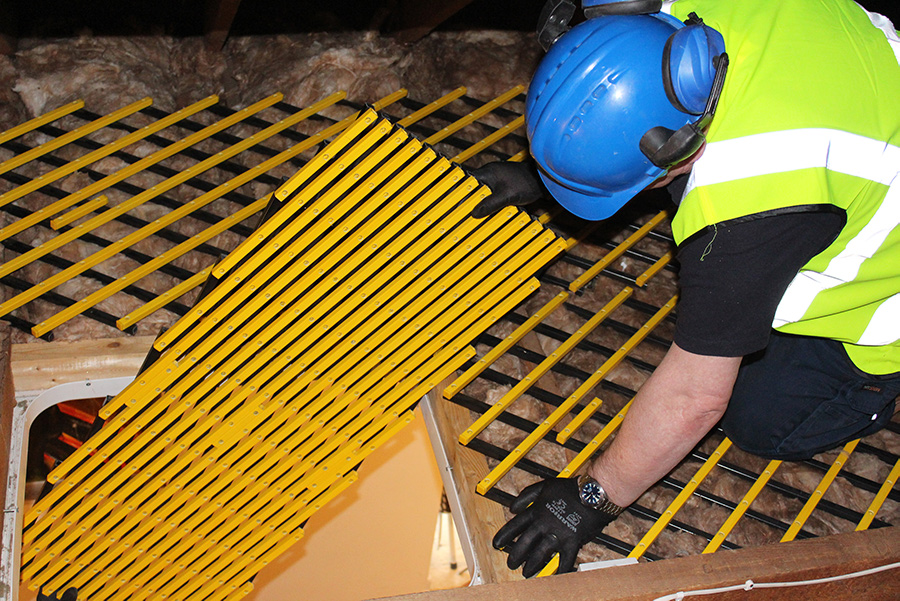4 Common Hazards During Solar Installation

Solar installations require specific attention to multiple high-hazard conditions. As many installations tend to utilize rooftop space, falls are probably the most widely known hazard, and rightfully so. However, focusing on just one hazard could lead to not enough attention being placed on others if the work hasn’t been properly planned. While there could always be additional dangers on a job site, the below list discusses some of the most common ones encountered during solar system installation.
1. Trips and Falls
As mentioned, falls are probably the first hazard that comes to mind for most people when dealing with solar installation since the work is often done on rooftops. Residential rooftops tend to pose an even greater challenge than large, flat commercial or industrial rooftops because of their slope and lack of fall protection options. You can’t necessarily purchase a bunch of weighted, standalone guardrails and set them on the edge of somebody’s home. It’s difficult to find existing fixtures that provide a solid anchor point. However, there are residential fall protection products on the market. The trick is to make sure you find the ones that work for the application and that your personnel is trained to install and use the products properly.
For flat roofs of commercial or industrial buildings, your options begin to open up. Counterweighted railings, parapet clamp rails, mobile anchor points, and more can be used depending on the configuration of the roof and the weight it can hold. As always, planning is critical. Lack of it may cause employees to tie off to the first thing they find without any knowledge of whether it is a suitable anchor point.
Keep in mind that the edge of the roof may not be the only place a fall hazard comes into play. Commercial buildings often have skylights that need to be treated as roof openings. Most skylight covers will not hold the weight of a person and the cages placed on them are usually just for protection from debris and animals. When designing your fall protection system, you may need to place rails, use skylight nets, or find other means of keeping your workers physically separated from skylights.
Ladders are also going to be widely used during solar installation, providing another opportunity for falls. If extension ladders are unavoidable, ensure they are set at the proper 4:1 ratio, that the base of the ladders are clear from debris and are set on solid, level ground. The ladder needs to extend 3’ above the roof level (or another handhold is available) and that the ladder is secured. Ladder walk-through toppers are a great tool to keep your workers from having to swing around the top of the ladder. Ensure that your workers are not trying to carry their tools and equipment up the ladder if it is taking away from their ability to maintain three points of contact.
If you are using a facility’s fixed ladders, ensure that the proper cages, wells, or fall protection devices are in place. All ladders will eventually require fall protection devices, but we are still in the phase-in period for that requirement. Make sure handholds are available 3’ above the roof and that your employees aren’t exiting a roof hatch right into a danger zone near a roof edge. For large installations, consider the idea of a stair tower if possible. While they do cost money and take some time to install, the safety they provide workers, as opposed to climbing ladders, is invaluable.
Lastly, in this category, don’t forget your slip and trip hazards. In addition to debris that could accumulate or tools that could be left lying around, solar installations are done in the weather which could pose slip and trip hazards. Water or ice need to be addressed if they pose a problem in the work area.
2. Electrical

It may seem self-evident that solar installations can pose electrical risks, but just what those electrical risks are may not be as obvious. Electrical hazards, during this type of work, could come in the form of either shock/electrocution from live equipment and utilities or it could come in the form of thermal injuries from heated panels. Some of this comes into play even more during the maintenance of solar systems, but in focusing on solar installation, the system will not have live power for most of the project. Once it is connected, though, lockout/tagout procedures need to be followed and special care needs to be taken around inverters. Until then, much of your electrical concern could come from existing utility installations. Ensure that your workers are at a distance from any potential hazards and/or are shielded in some way from them. Make sure you discuss these live utilities with your workers during a JSA (job safety analysis) so that they know not to approach if there is no way to install a physical barrier or get a shutdown. Be especially cognizant of these during any scaffold installation, hoisting of materials to the roof, or other tasks that could inadvertently take you closer to the lines than planned.
In addition, solar panels will continue to produce energy and heat up even with the power off. The only way to stop this is to cover them with an opaque material. Make sure all workers are fully aware of this, the proper precautions are being taken, and all the necessary PPE is being worn. Remember, even a minor incident could turn major. For example, somebody surprised by the heat of a panel could stumble backward and fall causing a secondary injury.
3. Strains and Sprains from Lifting
Solar panels and associated equipment can be heavy. They can be large and awkward to handle if not done properly. It is important to determine how your equipment and materials are going to be moved. Where possible and where needed, opt for material handling equipment such as rough terrain forklifts or material hoists to get everything up to the level on which you are working. Use carts to move that material around the roof if possible.
4. Cold/Heat
As previously noted, solar installations are performed in the weather. While work may stop during periods of rain or snow, it may not stop during periods of intense heat or cold. All precautions need to be taken to prevent heat and cold illnesses, beginning with training your workforce on the warning signs of each, what to do when a heat or cold illness is suspected, and how to prevent them in the first place. When the conditions warrant it, ensure that you are allowing your people frequent breaks and that they are getting out of the sun or the cold weather. Ensure that they are staying hydrated. In the cold weather, make sure they are staying dry. Take no chances. If the weather is going to be extreme, consider not working or for extreme heat, shifting your schedule to allow more time during the cooler hours of the day.
Conclusion
While falls are a major hazard during solar installations, they are clearly not the only ones to be concerned with. Proper training, planning, PPE usage, and equipment installation need to take place in order to mitigate the dangers associated with this work.
Here’s an extra safety tip!

You may find yourself having to work with electrical or structural needs inside an attic. Not every attic will have a suitable floor and you are exposed to a potential fall through. Besides the obvious risk to your health, you’ll also incur additional costs to fix the ceiling you just stepped through. The CoverSafe Spark is an expandable safety platform that provides a durable walkway or work area for preventing falls through attic openings that could cause injuries or collateral damage.



